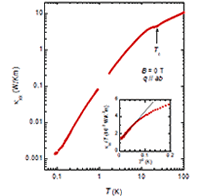Superconducting gap function of Iron-Pnictide Co-doped BaFe2As2
Published: January 31, 2010
The details of research
Since the discovery of superconductivity in iron oxypnictide , its superconductivity with high transition temperature Tc has attracted great attention because this system bears some analogy to high-Tc cuprates. However, in contrast to high-Tc cuprates, the fully gapped state has been reported by specific heat, penetration depth, angle resolve photoemission measurements and so on. What is intriguing in this system is that theoretically the antiferromagnetic fluctuations with Q = (p, 0) is expected to induce the sign-reversing s-wave superconductivity with fully opened gap, which is called "s±-wave state". Including the possibility of the s±-wave state, however, the nature of the superconductivity has not been clarified yet.
Yo Machida and co-workers have performed thermal conductivity measurements on the iron oxypnictide Ba(Fe1-xCox)2As2 (x = 0.07) in order to clarify the gap structure. They found a sizable residual T-linear term of the thermal conductivity, possibly due to the impurity-induced in-gap state. In addition, significant peak anomalies were observed in both thermal conductivity and thermal Hall conductivity originating from the prominent enhancement of the quasi-particle (QP) mean-free path below Tc. The field dependence of the delocalized QP density of states is apparently different from that of nodal gap excitation. These observations all point to the fully gapped sign-reversing s-wave state.
Reference
- Authors: Yo Machida, Kosuke Tomokuni, Takayuki Isono, Koichi Izawa, Yasuyuki Nakajima, and Tsuyoshi Tamegai
- Title of original paper: Possible Sign-Reversing s-Wave Superconductivity in Co-Doped BaFe2As2 Proved by Thermal Transport Measurements.
- Journal, volume, pages and year: J. Phys. Soc. Jpn. 78, 073705 (2009).
- Digital Object Identifier (DOI): 10.1143/JPSJ.78.073705
- Affiliations: Department of Physics, Tokyo Institute of Technology,
- Department website: http://izawa.ap.titech.ac.jp/

Figure caption: Temperature dependence of thermal conductivity κxx. The inset: κxx /T vs T2 plot under zero field.

. Any information published on this site will be valid in relation to Science Tokyo.



